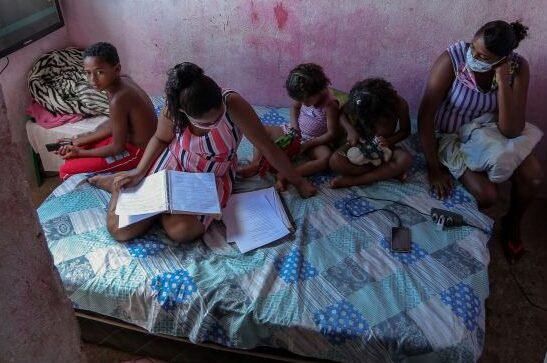Education is one of the key factors to break the endless cycle of poverty, yet almost 12 million children in the rural areas of Latin America struggle to access any type of formal education. In many remote areas, schools are far away, teachers are limited, and many families can not afford the various supplies needed for education. Additionally, some areas face difficult terrain making it difficult to attend school. Without education, students have fewer opportunities for a better future, continuing the cycle of poverty.
Challenges in Rural Education
Lack of Schools and Educators
One of the biggest problems that these communities face is the shortage of schools and teachers. Many small villages and rural areas don’t have a school nearby, forcing children to walk very long distances just to attend classes. In some areas, the only available schools were poorly funded and lacked basic resources such as books, desks, electricity, and more. This meant that even areas that had education still lacked basic educational resources, limiting the quality of education children could receive. This is caused by the preferences of teachers themselves, as they would much rather work in cities where they get better salaries and better resources, making it difficult to find educators who are willing to work in remote communities.
Economic Barriers
Another major obstacle to education is economic barriers, such as poverty. Many families in rural Latin American communities struggle to afford necessary living resources and stay alive day by day. This makes it even more difficult to account for the costs of school supplies and transportation costs. In some cases, children are even forced to work at a young age to help support their families with the economic struggle, leaving them with little time for education. This struggle is unfortunately common among communities all across Latin America, but specifically in Guatemala.
Poor Infrastructure
However, even when schools exist, they often lack quality and proper infrastructure. Some schools have no running water, electricity, or internet access, making it extremely difficult for students to learn efficiently. Additionally, in some remote areas, students are forced to go through dangerous paths, such as crossing rivers just to get to school. These difficult conditions discourage many from attending consistently and regularly, leading to a high dropout rate.
Communities often come together to face struggles, which in this case is the poor education quality and lack of educational resources. In certain areas, some people volunteer to educate the community when schools are unavailable. Additionally, people who visit the area and notice the harsh educational experience share the struggle on social media raising funds for those in need. Many groups and parents often get together to construct classrooms from the money raised and government funding. This collective community effort allows for a strong improvement in education for children in need.
Possible Solutions
Governmental and Non-Profit Programs
Government programs and non-governmental organizations (NGOs) are currently working all across Latin America to improve education conditions. For example, some governments provide free school meals to encourage attendance, while also giving other financial options to those who need it most. Other programs, such as NGOs and non-profits also play an important role by donating resources, providing training, and building schools in remote locations.
Technology and Online Learning
New technology is helping us immensely to end the inequality in education in rural communities. This technology allows students to virtually learn off of tablets and laptops with pre-downloaded educational materials. This ensures that students in remote locations without the Internet can still learn from anywhere, at any time. Specifically, this is very beneficial in areas with a lot of mountain terrain, like Peru where it is hard to construct physical schools.
Community Impact
Communities often come together to face struggles, which in this case is the poor education quality and lack of educational resources. In certain areas, some people volunteer to educate the community when schools are unavailable. Additionally, people who visit the area and notice the harsh educational experience share the struggle on social media raising funds for those in need. Many groups and parents often get together to construct classrooms from the money raised and government funding. This collective community effort allows for a strong improvement in education for children in need.
Conclusion
Access to education should never be a privilege, but a right for every child across the world, regardless of where they live. However, in the remote locations of Latin America, millions of children still sit in classrooms with broken desks, walk through dangerous terrain to school, or drop out entirely. Despite these struggles, hope remains through the various communities, volunteers, and people across the world coming together to make a difference.
Nonetheless, change doesn’t occur alone. You can be a part of the solution. From spreading awareness to directly volunteering, every effort counts. These children have dreams just like us, yet don’t have the same opportunity to chase them and achieve their life-long goals. Will you help open the doors of education for a better future?
Works Cited
Chiapas, in. “Ballard Brief.” Ballard Brief, 27 Feb. 2024,
ballardbrief.byu.edu/issue-briefs/lack-of-access-to-quality-education-for-rural-indigenous
-communities-in-chiapas-mxico?utm_source=chatgpt.com. Accessed 1 Feb. 2025.
Group, World Bank. “Tackling the Learning Crisis in Latin America and the Caribbean.” World
Bank, World Bank Group, 12 Apr. 2024,
www.worldbank.org/en/results/2024/03/22/tackling-the-learning-crisis-in-latin-america-a
nd-the-caribbean?utm_source=chatgpt.com. Accessed 1 Feb. 2025.
Hartig, Thomas. “Education in Latin America.” NPH, 22 Feb. 2024,
nph.org/education-in-latin-america/.
“Reimagine Education in Latin America and the Caribbean.” Unicef.org, 2021,
www.unicef.org/lac/en/reimagine-education-latin-america-and-caribbean?utm_source=ch
atgpt.com. Accessed 1 Feb. 2025.
